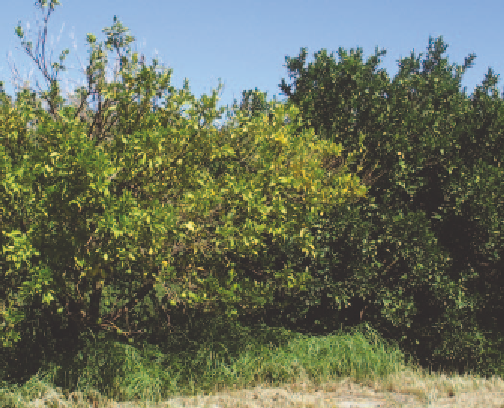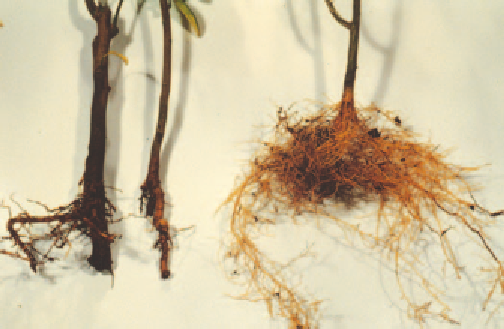Agriculture Reference
In-Depth Information
PHYTOPHTHORA
■
Cause
Numerous oomycetes of the genus
Phytophthora
can cause
disease on citrus. The common causes of Phytophthora
diseases in Australia are
P. citricola, P. citrophthora,
P. hibernalis, P. nicotianae
and
P. palmivora
.
characteristic pungent odour and fall readily. In wet
weather, a white, fungal growth appears on the surface
of the rotted area. As symptoms develop one week after
infection, brown rot can be a serious postharvest
problem.
Gummosis: gummosis is a common, although not
diagnostic, symptom of Phytophthora infection in trees,
and is characterised by the exudation of large amounts
of gum on the outside of the bark. Gummosis can occur
on the trunk, or even on branches in the canopy under
highly conducive weather conditions. Before the gum
exudes externally, it is produced by the living cells of the
young wood beneath the bark, and can accumulate near
the cambium, building sufficient pressure to separate
the bark from the wood. Eventually, the pressure is
Symptoms
Root rot: this is a colourless or tan to dark brown decay
of feeder roots, which may extend into the larger
secondary and primary roots causing root-lesions and
extensive discolouration and death of the root system.
When affected roots are pulled from the soil, the outer
decayed bark and cortex sloughs off leaving the woody
central portion of the root exposed. Yellowing of the
leaves, defoliation and twig dieback is a common
consequence of Phytophthora root rot, particularly the
loss of feeder roots. New growth is weak and lacks vigour.
One branch or side of the tree may be more seriously
affected than the others depending on where the root
damage is occurring.
Collar rot: the main symptom is dark, water-soaked
areas of bark overlaying pale brown discoloured
cambium and sapwood tissue, often with gum exudation
on the trunk near ground level. On Phytophthora-
susceptible rootstocks, infection either progresses from
the major roots up the trunk, or direct infection of the
trunk occurs through wounds. Collar rot also occurs on
susceptible scions where the bud union is close to the
ground. Dead bark dries out, cracks and breaks away
from the wood in vertical strips. On cutting through the
bark, a distinct brown discolouration is evident in the
underlying wood, and this may extend beyond the area
of the external bark symptoms. The margin between
diseased and healthy wood is distinct. The canopy of
trees with collar rot is often yellow, becomes sparse and
results in poor crops of undersized fruit until death
occurs within a few years.
Fig 6.31 Root rot symptoms on a susceptible rootstock of rough
lemon (left) and a resistant rootstock
Poncirus trifoliata
(right).
Brown rot: leaf symptoms include blackening or brown
discolouration and death of young tip growth. Dark,
water-soaked areas occur on leaves, particularly at the
tips and along the margins. Affected leaves often fall
while still green. Fruit symptoms are first seen as a light
brown discolouration of the rind on one side of the
fruit. The affected area remains more or less circular as
it enlarges, and may eventually cover the entire fruit.
The rot penetrates deep into the fruit, but generally
remains firm and becomes darker in colour and
leathery in appearance. Infected fruit have a
Fig 6.32 Tree affected by Phytophthora root and collar rot, showing
yellowing, twig dieback and defoliation. A healthy tree is to the right.
Similar symptoms are produced by other root pathogens.













